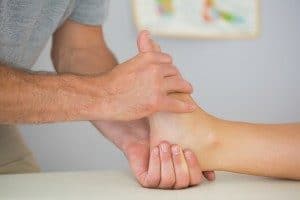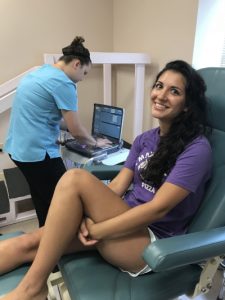Gymnastics Injuries

Common Gymnastics Injuries: Treatment and Prevention
 Gymnastics is a relatively injury prone sport for young girls, with nearly 100,000 gymnasts injured yearly. Younger athletes are being trained younger, spending extra time in training. They are asked to perform harder and harder skills as the skill-ceiling continues to rise. Here, we will go over some very helpful tips that can help stave off Gymnastics injuries and improve performance.
Gymnastics is a relatively injury prone sport for young girls, with nearly 100,000 gymnasts injured yearly. Younger athletes are being trained younger, spending extra time in training. They are asked to perform harder and harder skills as the skill-ceiling continues to rise. Here, we will go over some very helpful tips that can help stave off Gymnastics injuries and improve performance.
Common Gymnastics Injuries
Gymnasts are expected to be both powerful and exhibit a level of grace worthy of competition. To make this happen, trainees must first develop the skills they’ll utilize. Once they’ve mastered the technique, they’ll begin to incorporate elements that add style and elegance to their routine. As the gymnasts utilize both their arms and legs in their routine, both are often at risk for inevitable injuries. These include bruises and scrapes, but are also prone to much more serious ankle injury.
The first and most important lesson a gymnast should learn is how to fall and land properly, as to avoid head, spine, neck or wrist injuries. Scrapes and bruises are typical and often require very minimal if any medical intervention, but for more serious incidents, like the following, medical advisement is recommended:
- An awkward landing
- A slip-up on the balance bar (the threat for injury isn’t negated if the landing is made)
- Irregular pain after continuously practicing a skill.
Head injuries should be definitely be examined by a professional as soon as possible. It is not always clear if it is a mild injury or a severe one, as symptoms may not appear right away. For foot and ankle injuries, the experts at BVFC are more than able to assist in your young one’s recovery and will be able to work side-by-side with your pediatrician for optimal results.
Causes of Gymnastics Injuries
- Poor flexibility
- A weakening of the arms, legs or core
- Poor balance
- An imbalance in one side of the body’s strength or flexibility
Overuse Injuries in Gymnastics
Overuse injuries in gymnastics are often the result of repetitive movements, causing muscular and/or flexibility imbalances. An example of this type of movement would be favoring one side of your body while training, and working out only that side’s muscles/elasticity.
Imbalances in strength or flexibility
Furthermore, as many athletes are not ambidextrous, “righties” and “lefties” will have to take special care to ensure that they aren’t favoring too heavily their dominant side. In gymnastics, the leg that the athlete leads with when performing maneuvers such as a handstand or cartwheel will often dictate which side they are more in-tune with, and it is recommended that they aim to strengthen the opposite side to a point where they are comfortable leading with both sides.
Gymnastics injuries Treatment:
Diagnostics – X-Ray imaging is very widely used by almost all healthcare professionals. Its primary purpose is visualizing bone fractures, joint dislocations, and misalignments.
K-Laser- Multiple settings available with the ability to penetrate all tissue depths and types. Protocols consist of 4-10 treatments and maintenance as needed. You may experience quick pain relief and receive the benefits of biostimulatory properties after following a full course of sessions for optimal care. The treatment is painless, many patients report a warm, sensational feeling during treatment.
How can gymnasts safely return to their sport after an injury?
Safely returning to gymnastics after an injury involves several key steps to ensure proper healing and to prevent re-injury. Here are some important guidelines:
- Follow Medical Advice: Adhere to your healthcare provider’s recommendations and timeline for returning to activity. Do not rush the process.
- Complete Rehabilitation: Ensure that you complete all physical therapy and rehabilitation exercises prescribed to restore strength, flexibility, and range of motion.
- Gradual Progression: Start with low-impact activities and gradually increase the intensity and complexity of your training as your body adapts and heals.
- Strength Training: Focus on strengthening the muscles around the injured area to provide better support and prevent future injuries.
- Flexibility Exercises: Incorporate stretching and flexibility exercises to ensure that the injured area and surrounding muscles are supple and less prone to injury.
What is the impact of repetitive movements on a gymnast’s joints?
Repetitive movements in gymnastics can have significant impacts on a gymnast’s joints, often leading to overuse injuries and other issues. Here are some of the key impacts:
- Wear and Tear: Continuous stress on the joints can cause the cartilage to wear down, leading to conditions such as osteoarthritis over time.
- Inflammation: Repetitive movements can lead to chronic inflammation of the joints, resulting in conditions like tendinitis or bursitis.
- Microtrauma: Small, repeated injuries to the joint structures can accumulate, causing pain and functional limitations.
- Stress Fractures: High-impact repetitive activities can lead to stress fractures in the bones around the joints.
How long should a gymnast rest after sustaining a significant injury?
The rest period for a gymnast after a significant injury varies depending on the type and severity of the injury. Generally, it can range from a few weeks to several months. It’s crucial to follow the healthcare provider’s recommendations and ensure complete healing before resuming full training and competition activities.
HOW IS INJURY PREVENTABLE?
By adhering to recommended training rules, employing safety gear, and using the following advice, many gymnastics injuries can be avoided:
- Wear all necessary protective equipment anytime you are competing or practicing, such as wrist guards, hand grips, footwear, ankle or elbow braces, and padding.
- Do not “play through the pain”; instead, go to the doctor if you are wounded and fully adhere to all treatment and rehabilitation recommendations.
- A first aid station should be present at all contests and practices.
- Make sure the equipment is in good working order by checking the padded floors, the mats underneath each device, and the safety harnesses for learning challenging moves.


